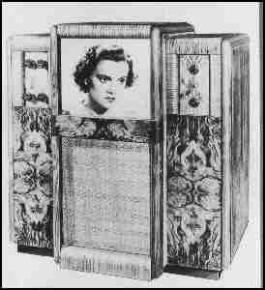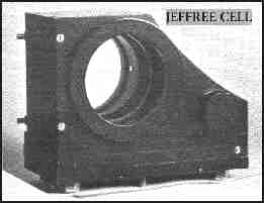|
Television Experimenters.com
Scophony System
The English Scophony system is probably the most interesting and the least known of the scanning methods described here. In spite of the fact that without a doubt, the Scophony systems provided the highest performance ever achieved with mechanical scanners.
In 1938, Scophony showed and successfully demonstrated three types of 405 line mechanical television receivers at the annual Radiolympia show in England. One was a home receiver, in a cabinet that produced a picture approximately 24" by 22". The other two were of similar construction, but without cabinets, intended for theater type operation. One produced a 6 by 5 foot picture and the other, 9 by 12 feet. Several of the theater models were installed and operating successfully. None of these receivers were sold because their production was halted due to the oncoming war in Europe.
The Scophony system consisted of several unique innovative devices working together. It used a new "split focus" optical system coupled to a "Jeffree Cell," light modulator and special high speed synchronous motors to drive the scanners. Each were important fundamental Scophony inventions, developed by them for their mechanical scanning systems. |

|
The split focus optical system invented by G. W. Walton, was developed specifically for use with mirror scanning systems. Focusing of light beams was accomplished by crossed cylindrical lenses, concentrating the light in two planes. This technique allowed the efficient use of smaller lenses and mirrors in the optical system, thereby reducing size and cost of the scanning equipment. This was especially important to Scophony because of their intent to produce very large picture sizes, normally requiring large costly optic elements.
|
The Jeffree cell was the light modulator used in the Scophony system. Developed in by J. H. Jeffree in 1934, it was a major improvement over the Kerr cell, both in efficiency and ease of
operation. As much as 200 times (not percent), more modulated light was available at the screen because it had the ability to store image elements. Its principle of operation was that if a supersonic mechanical oscillation passes through a transparent fluid in which a beam of light, perpendicular to the wave front is also passing, a series of retardations and accelerations of the light beam will occur. These oscillations in the fluid, properly controlled act much like a diffraction grating and will cause selective cancellations of the light waves passing through the fluid. By matching the speed of the sonic wave front through the fluid, to the speed of the scanning beam passing through the cell, the wave front could act on the light passing through for much longer times. This resulted in higher levels of modulated light being passed on to the scanning mirrors. Optical devices using the same principle of operation as the Jeffree cell have been "re-invented" in recent years for applications in television and lasers. This was a device well ahead of its time.
|

|
The Scophony system used two mirror drums one as a low speed scanner with 12 mirrors operating at approximately 240 RPM. A high speed scanner with 20 mirrored surfaces ran at 30,375 RPM for a 405 line transmission. When set up
for the American 441 line system, the high speed scanner turned at 39,690 RPM. The high speed motors proved good for at least 1000 hours of use and most went many times longer with no measurable wear. Considering that the year was 1938, this was an outstanding accomplishment. At the same time, Scophony was developing synchronous motors that could operate at 150,000 RPM. |

|
The period between 1932 and 1939 was the "coming of age" for television. In England and European countries, television as a service was developing to the point where program content was becoming more important than the novelty of television. These years were also the "coming of age" for mechanical systems During the earlier years, mechanical television offered many advantages over cathode ray systems and innovation was the rule. During these years, mechanical television offered many advantages over most cathode ray systems. Important advantages like, brighter, sharper, larger pictures. They also offered longer life, lower maintenance costs and
better reliability. There was no popular resistance to mechanical systems as there might today and some receivers were being sold. As result, there was an ongoing effort on the part of many companies to improve existing equipment and develop new ideas. World War II completely ended the activity in mechanical television but generated an intense interest in cathode ray tubes and their associated circuits. The reason??.. It was RADAR! Radar needed to have the same cathode ray tubes, only bigger and better in many ways. The same circuits only faster, more responsive. By the end of the war, there had been so much progress in radar development; much of which could be transferred directly back to television, so that the first commercial receivers after the war included 15" and 20" direct view models as well as projection sets providing newspaper sized images.
However, we are not rid of mechanical television as yet. Even today, some 75 years after John Logie Baird was able to show that dim flickering image of a young boy on his apparatus, just about all of us continue to buy, use and generally accept mechanical television systems in our homes. These are commonly referred to as "VCRs" and "DVD Players." Most of us have at least one. I have three, one of which (a Panasonic) is 20years old and has never required service of any sort. And it is still used occassionally. That says much about the concern for reliability on mechanical systems.
A recent development is the "DLP", digital light processor, consisting of approximately a million light reflecting mirrors, in a space the size of your thumbnail. This is an integrated circuit sort of device developed by Texas Instruments, where the mirrors actually physically move under the control of a video signal. It's an amazing device and can be found in many of the new "High Definition" sets seen in the stores today.
Peter F. Yanczer |

All rights reserved. |
|